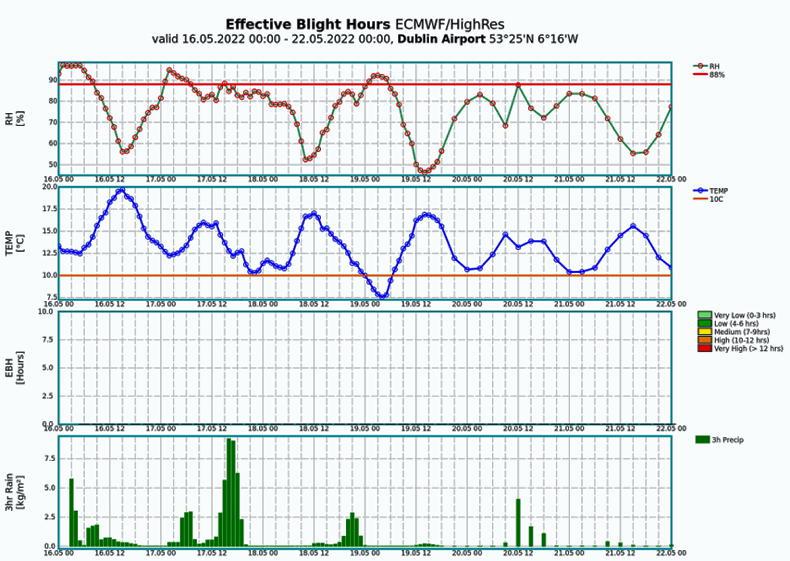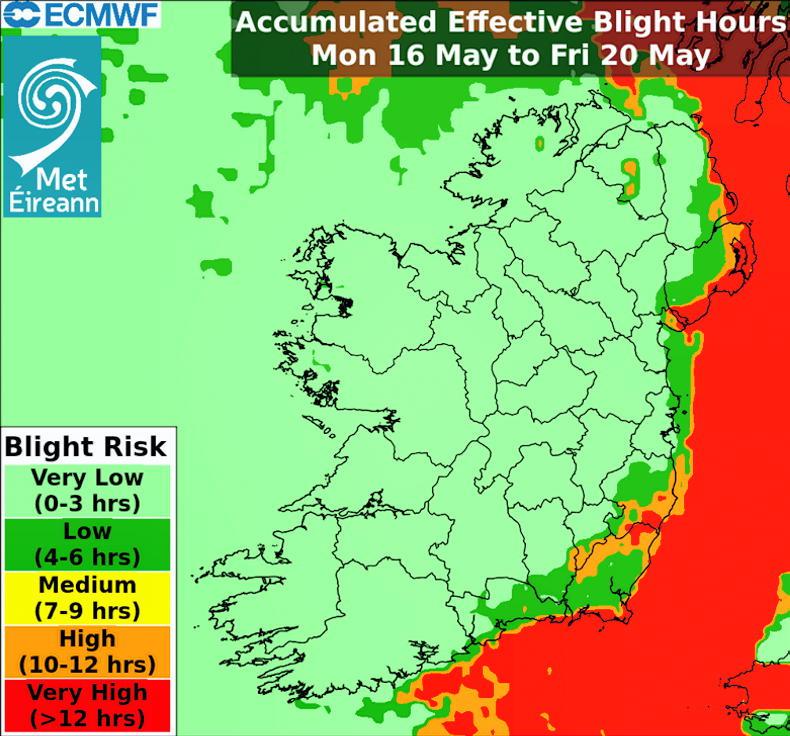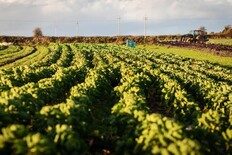Since its arrival in Ireland almost 177 years ago, potato late blight, caused by the pathogen Phytophthora infestans, has been a constant threat to Irish potato crops and can have devastating consequences on the crop.
While our ancestors struggled to understand what was happening as late blight rapidly defoliated and rotted their crops in autumn 1845, we now have both the knowledge and technologies available to minimise the impact of the disease.
Our ability to forecast or predict potential weather conditions that favour the disease combines both of these.
Shortly after its arrival in Europe, it was apparent that there was an association with whatever was causing the potato to die with weather conditions, with mild damp conditions favouring its development and spread. This knowledge was used by Austin Bourke of Met Éireann in the mid-1950s to devise the “Irish Rules” for blight forecasts.
Rules on blight forecasting
These rules set out the conditions that allow for the development and spread of the disease, and have been used since to forecast or predict late blight favourable weather conditions.
The rules were established using both published reports on the biology of the pathogen, P. infestans, eg what temperature does it need to survive and thrive, and reports of outbreaks reported throughout the country in the early 1950s.
Simply put, after 12 hours of temperatures >10°C and relative humidity >90%, the conditions are favourable for late blight.
If, after this, rain is forecast then the clock starts and every hour after this where these conditions continue to be met are referred to as an effective blight hour (EBH).
If no rain is forecast but these conditions continue to be met, then the clock starts at the 16th hour. This meant that once 12 consecutive EBHs were forecast a warning was issued by Met Éireann giving growers advance notice that conditions favourable to blight were to occur.
The rules very much amount to a warm front slowly moving across the country, typical of an Irish midsummer’s day.
As there was very little in the form of fungicide available for control in the 1950s, other than bluestone (copper sulphate), the Irish Rules were very effective for their time as they forecast when those limited fungicides would be of most value.
Potato production has changed
Over the last 60 years, production has dramatically changed. A once extensive industry is now highly intensive and specialised, mostly located in specific regions of the country servicing the main urban centres.
Where once one or two fungicides were available, potato growers now have a suite of fungicides, each with different properties that allow them to target different stages of the crop’s development to maximise coverage and protection.
Equally, the technologies to apply these fungicides have changed, with greatly increased capacity to ensure no crop is left overly exposed during broken weather conditions.
The pathogen itself has also changed, with more aggressive strains of P. infestans emerging and making their home in Irish crops.
Why use a forecasting system?
Given the risks of crop loss associated with late blight, why should growers use a forecasting or predictive system?
Only growers know the heartache of trying to get on top of late blight if it does get into a crop
This is an extremely valid question. The investment in growing a hectare of potatoes is massive by all accounts and only growers know the heartache of trying to get on top of late blight if it does get into a crop.
However, one of the major costs associated with growing potatoes is the fungicides used for late blight control. With anywhere between 15 and 20 applications required each season, the potential to drop some of these from the programme either by stretching the intervals (seven-day intervals is standard practise) or by reducing the dose applied (full doses are also standard) can lead to substantial savings.
Such reductions can of course only be made with the confidence that doing so doesn’t allow blight to get a foothold. The warnings previously issued by Met Éireann clearly didn’t provide this confidence and based on experimental evidence growers were right to be sceptical.
To address this, a collaborative project was undertaken between Teagasc, Met Éireann and Maynooth University to evaluate if changes could be made to the rules to forecast late blight to improve their predictive ability.
Using disease outbreak data generated as part of the Teagasc potato breeding programme between 2007 and 2016, various changes to the rules were tested. These culminated in changing the relative humidity to 88% for a shorter period of 10 hours and also the addition of relative humidity >90% or rainfall greater than or equal to 0.1mm to trigger the clock to start counting EBHs.
Unlike previously, where >12 EBHs were required to issue a warning, it was proposed that a more dynamic forecast be provided where forecasted periods, including the specific weather conditions themselves are provided so growers can assess risk for their specific location.
Initially, this was a desk exercise with hypothetical reductions in fungicide extrapolated over the 10-year period estimated to be 50%, with reductions in the number of applications also possible.
As with all retrospective desk studies it was impossible to demonstrate that this was an actual possibility so during the summers of 2017 to 2019 field trials were conducted in Oak Park.
These trials were conducted across a range of potato varieties differing in their resistance to late blight, with comparisons between fungicide programmes (standard, reduced dose or flexible dose based on revised model).
The summers of 2017 to 2019 represented three extremely contrasting potato growing seasons when it came to late blight, with the summer of 2019 an ideal season to test efficacy in the presence of high pressure. 2018 was a season to demonstrate where dramatic reductions could be made with drought more of a problem than blight.
Across the three seasons, no differences in levels of late blight, yield or even the P. infestans population were detected between the programmes, with significant reductions in fungicide quantities possible.
Combined with the desk work, these findings provide the foundations for further work, at the very least making the changes to the warnings issued by Met Éireann to reflect the improved revisions.
New blight forecast
In spring 2022, Met Éireann incorporated these changes into its blight forecast and they can now be seen on its website under Weather Warnings and Advisories (www.met.ie/forecasts/blight-forecast).
The page contains Blight Maps, where three- to five-day risk forecasts are provided.

Risk is categorised based on forecasted accumulations of EBHs as very low (0-3 EBH), low (4-6 EBH), medium (7-9 EBH), high (10-12 EBH) and very high (>12 EBH).
The three- to five-day maps provide an overview of how the risk is changing. In addition, the page also provides more detailed blight meteograms for a small number of locations. These provide a greater level of detail, including detailed rainfall and relative humidity forecasts for these locations.
As the accumulation of EBHs is very much based on a threshold, using the blight maps in conjunction with these meteograms will provide increased detail to growers to know why EBHs are not being accumulated (eg relative humidity just slightly below 88% for instance). It is hoped over time that the number of locations for which meteograms are provided will increase to reflect the regions where production is based.

Meteograms an element of managementWe must be careful in how we interpret these maps and meteograms. They can only provide information on one component of late blight, forecasted weather.
What other risks exist in your crops?Is there blight there already?Is blight in the local surroundings?What is the susceptibility of the crop you are growing to blight?Where on your farm are you growing the crop?We must be realistic as to what these forecasts can achieve, they cannot take account of local topologies or field positions, etc.
They will not tell you if blight is present or how much fungicide might be required.
These are all individual issues, and in the case of fungicide rates, such decisions will differ depending on the grower. What the risk predictions do provide is guidance and it is up to individual growers to utilise this according to their system.
So, for the season ahead I suggest that growers become familiar with the predictions, follow them through the season – do they match your perceived risk for your crops?
Maybe if possible set aside a small area where you might be willing to take a bit of risk, somewhere you can monitor and respond easily if blight does get in.
Since its arrival in Ireland almost 177 years ago, potato late blight, caused by the pathogen Phytophthora infestans, has been a constant threat to Irish potato crops and can have devastating consequences on the crop.
While our ancestors struggled to understand what was happening as late blight rapidly defoliated and rotted their crops in autumn 1845, we now have both the knowledge and technologies available to minimise the impact of the disease.
Our ability to forecast or predict potential weather conditions that favour the disease combines both of these.
Shortly after its arrival in Europe, it was apparent that there was an association with whatever was causing the potato to die with weather conditions, with mild damp conditions favouring its development and spread. This knowledge was used by Austin Bourke of Met Éireann in the mid-1950s to devise the “Irish Rules” for blight forecasts.
Rules on blight forecasting
These rules set out the conditions that allow for the development and spread of the disease, and have been used since to forecast or predict late blight favourable weather conditions.
The rules were established using both published reports on the biology of the pathogen, P. infestans, eg what temperature does it need to survive and thrive, and reports of outbreaks reported throughout the country in the early 1950s.
Simply put, after 12 hours of temperatures >10°C and relative humidity >90%, the conditions are favourable for late blight.
If, after this, rain is forecast then the clock starts and every hour after this where these conditions continue to be met are referred to as an effective blight hour (EBH).
If no rain is forecast but these conditions continue to be met, then the clock starts at the 16th hour. This meant that once 12 consecutive EBHs were forecast a warning was issued by Met Éireann giving growers advance notice that conditions favourable to blight were to occur.
The rules very much amount to a warm front slowly moving across the country, typical of an Irish midsummer’s day.
As there was very little in the form of fungicide available for control in the 1950s, other than bluestone (copper sulphate), the Irish Rules were very effective for their time as they forecast when those limited fungicides would be of most value.
Potato production has changed
Over the last 60 years, production has dramatically changed. A once extensive industry is now highly intensive and specialised, mostly located in specific regions of the country servicing the main urban centres.
Where once one or two fungicides were available, potato growers now have a suite of fungicides, each with different properties that allow them to target different stages of the crop’s development to maximise coverage and protection.
Equally, the technologies to apply these fungicides have changed, with greatly increased capacity to ensure no crop is left overly exposed during broken weather conditions.
The pathogen itself has also changed, with more aggressive strains of P. infestans emerging and making their home in Irish crops.
Why use a forecasting system?
Given the risks of crop loss associated with late blight, why should growers use a forecasting or predictive system?
Only growers know the heartache of trying to get on top of late blight if it does get into a crop
This is an extremely valid question. The investment in growing a hectare of potatoes is massive by all accounts and only growers know the heartache of trying to get on top of late blight if it does get into a crop.
However, one of the major costs associated with growing potatoes is the fungicides used for late blight control. With anywhere between 15 and 20 applications required each season, the potential to drop some of these from the programme either by stretching the intervals (seven-day intervals is standard practise) or by reducing the dose applied (full doses are also standard) can lead to substantial savings.
Such reductions can of course only be made with the confidence that doing so doesn’t allow blight to get a foothold. The warnings previously issued by Met Éireann clearly didn’t provide this confidence and based on experimental evidence growers were right to be sceptical.
To address this, a collaborative project was undertaken between Teagasc, Met Éireann and Maynooth University to evaluate if changes could be made to the rules to forecast late blight to improve their predictive ability.
Using disease outbreak data generated as part of the Teagasc potato breeding programme between 2007 and 2016, various changes to the rules were tested. These culminated in changing the relative humidity to 88% for a shorter period of 10 hours and also the addition of relative humidity >90% or rainfall greater than or equal to 0.1mm to trigger the clock to start counting EBHs.
Unlike previously, where >12 EBHs were required to issue a warning, it was proposed that a more dynamic forecast be provided where forecasted periods, including the specific weather conditions themselves are provided so growers can assess risk for their specific location.
Initially, this was a desk exercise with hypothetical reductions in fungicide extrapolated over the 10-year period estimated to be 50%, with reductions in the number of applications also possible.
As with all retrospective desk studies it was impossible to demonstrate that this was an actual possibility so during the summers of 2017 to 2019 field trials were conducted in Oak Park.
These trials were conducted across a range of potato varieties differing in their resistance to late blight, with comparisons between fungicide programmes (standard, reduced dose or flexible dose based on revised model).
The summers of 2017 to 2019 represented three extremely contrasting potato growing seasons when it came to late blight, with the summer of 2019 an ideal season to test efficacy in the presence of high pressure. 2018 was a season to demonstrate where dramatic reductions could be made with drought more of a problem than blight.
Across the three seasons, no differences in levels of late blight, yield or even the P. infestans population were detected between the programmes, with significant reductions in fungicide quantities possible.
Combined with the desk work, these findings provide the foundations for further work, at the very least making the changes to the warnings issued by Met Éireann to reflect the improved revisions.
New blight forecast
In spring 2022, Met Éireann incorporated these changes into its blight forecast and they can now be seen on its website under Weather Warnings and Advisories (www.met.ie/forecasts/blight-forecast).
The page contains Blight Maps, where three- to five-day risk forecasts are provided.

Risk is categorised based on forecasted accumulations of EBHs as very low (0-3 EBH), low (4-6 EBH), medium (7-9 EBH), high (10-12 EBH) and very high (>12 EBH).
The three- to five-day maps provide an overview of how the risk is changing. In addition, the page also provides more detailed blight meteograms for a small number of locations. These provide a greater level of detail, including detailed rainfall and relative humidity forecasts for these locations.
As the accumulation of EBHs is very much based on a threshold, using the blight maps in conjunction with these meteograms will provide increased detail to growers to know why EBHs are not being accumulated (eg relative humidity just slightly below 88% for instance). It is hoped over time that the number of locations for which meteograms are provided will increase to reflect the regions where production is based.

Meteograms an element of managementWe must be careful in how we interpret these maps and meteograms. They can only provide information on one component of late blight, forecasted weather.
What other risks exist in your crops?Is there blight there already?Is blight in the local surroundings?What is the susceptibility of the crop you are growing to blight?Where on your farm are you growing the crop?We must be realistic as to what these forecasts can achieve, they cannot take account of local topologies or field positions, etc.
They will not tell you if blight is present or how much fungicide might be required.
These are all individual issues, and in the case of fungicide rates, such decisions will differ depending on the grower. What the risk predictions do provide is guidance and it is up to individual growers to utilise this according to their system.
So, for the season ahead I suggest that growers become familiar with the predictions, follow them through the season – do they match your perceived risk for your crops?
Maybe if possible set aside a small area where you might be willing to take a bit of risk, somewhere you can monitor and respond easily if blight does get in.









 This is a subscriber-only article
This is a subscriber-only article










SHARING OPTIONS: